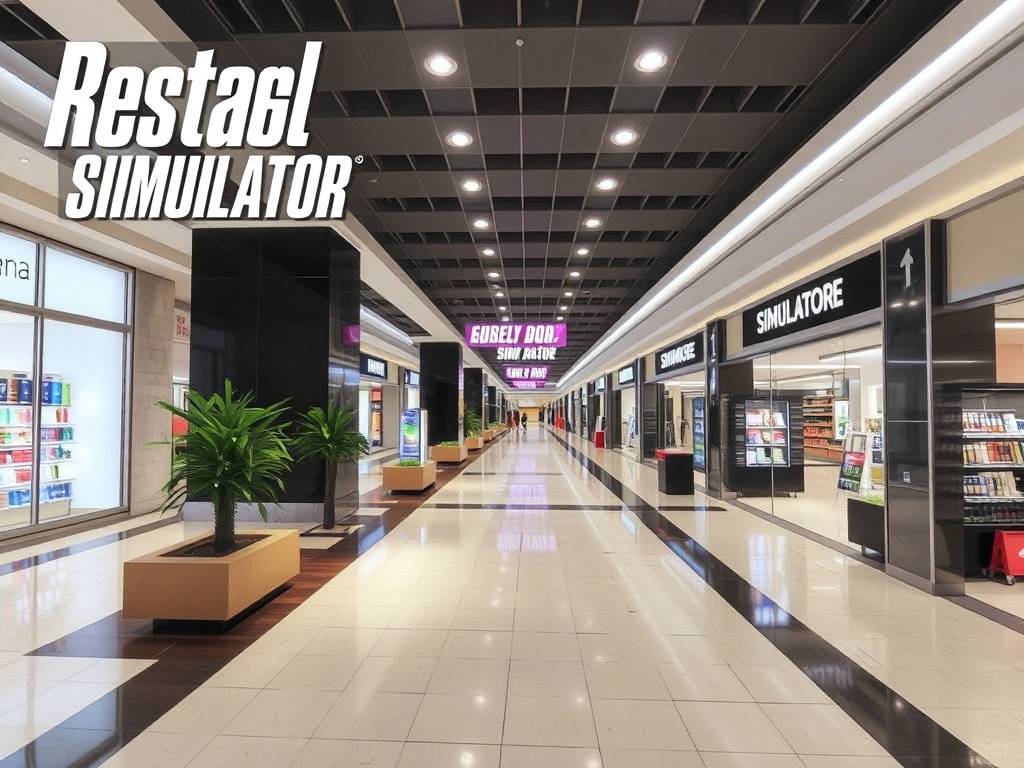Imagine stepping through the grand, gleaming doors of your very own shopping center. The polished marble floor reflects the soft, ambient lighting, and the gentle hum of a thriving retail ecosystem surrounds you. This isn't a dream, nor is it a physical location. This is the future of virtual commerce, made possible by the groundbreaking Retail Simulator VR and its latest, most ambitious update: the Mall Expansion. This isn't just an add-on; it's a paradigm shift, transforming a powerful boutique management tool into a comprehensive virtual mall management platform.
For aspiring entrepreneurs and seasoned retail moguls alike, the leap from a single store to an entire mall has always been a monumental challenge. The capital, the logistics, the sheer scale of operations—it's a daunting prospect. The VR shopping mall expansion elegantly demolishes these barriers. It allows you to build, manage, and optimize a multi-story retail paradise from the ground up, all within an immersive virtual environment. This is the ultimate tool for anyone looking to master the art and science of large-scale retail without the real-world financial risk.
The first, and most profound, step in this journey is the shift in perspective. You are no longer just a store manager; you are a master planner, an architect of experiences. The blank canvas of your virtual land is yours to shape. The core question of how to design a virtual shopping mall becomes your primary focus. You begin with the macro layout. Do you opt for the classic double-loaded corridor, a racetrack loop that encourages circular foot traffic, or a more modern, open-atrium design? Each choice has profound implications for tenant visibility and customer flow. Placing anchor stores—a massive department store, a flagship electronics retailer, or a sprawling entertainment complex—at opposite ends of the mall is a classic retail strategy for VR. This "draw and pull" effect naturally guides avatars through the entire concourse, exposing them to all the smaller kiosks and specialty shops in between.

With the skeleton of your mall in place, the next phase is about breathing life into it through tenancy. This is where the virtual store leasing simulation comes into play. You become a commercial landlord, actively curating a tenant mix that creates a synergistic retail environment. The goal is to avoid cannibalization and promote cross-shopping. Placing a high-end jewelry store next to a budget fast-fashion outlet might not be ideal. However, positioning a gourmet coffee shop near a bookstore and a comfortable seating area creates a natural and profitable destination cluster. You'll negotiate virtual leases, consider tenant fit-outs, and manage the delicate balance of having just the right number of competing brands to foster healthy competition without saturating the market. This process provides invaluable, risk-free training in commercial property management in VR.
Once your mall is populated, the real work of optimization begins. This is the heart of the Retail Simulator VR experience, now operating on a grand scale. The game provides a torrent of data through its advanced analytics dashboard. You're not just guessing what works; you're making data-driven decisions. The VR customer behavior analysis tools are more critical than ever. Heat maps will show you exactly where avatars congregate, linger, and, just as importantly, where they speed through without a second glance. Are they avoiding a particular wing? The data will tell you. Perhaps the lighting is too dim, or the storefronts in that area are not engaging enough. You can A/B test everything from music genres and scent diffusion (virtually simulated, of course) to seasonal decorations and promotional signage, observing in real-time how these changes affect dwell time and conversion rates.
A modern mall is more than a collection of stores; it's an experience hub. The Mall Expansion allows you to integrate a wide array of immersive retail experiences that keep customers coming back. You can build a state-of-the-art virtual cinema, a family-friendly VR arcade, or even a concert venue for virtual live events. These entertainment anchors are not just revenue streams; they are powerful drivers of foot traffic. A customer comes to see a movie but decides to arrive early for a meal at the food court and browse the electronics store afterward. This ecosystem is the key to thriving in the age of experiential retail. Furthermore, integrating interactive product demos in VR within your stores allows customers to not just see a product but to experience it—test-driving a virtual car, trying on digital clothing that perfectly fits their avatar, or sampling the sound quality of headphones in a simulated environment.
The economic simulation running beneath the beautiful visuals is incredibly sophisticated. You are tasked with full mall financial management simulation. This involves monitoring macro-level Key Performance Indicators (KPIs) like total mall footfall, average spend per visitor, and sales per square foot. You manage centralized expenses such as security, utilities, janitorial services, and marketing campaigns for the entire mall. You must decide on the allocation of your marketing budget—should you run a mall-wide "Winter Sale" event or targeted social media ads to drive traffic to a new tenant? Mastering this financial layer is what separates a profitable mall from a vacant one. It’s a deep dive into virtual mall financial management simulation that teaches cash flow management on a massive scale.
For the creatively inclined, the customization options are nearly limitless. The expansion includes an extensive library of architectural elements, furniture, foliage, and decorative items. This allows for deep VR mall customization and personalization. You can create distinct thematic zones—a futuristic tech wing with neon accents and sleek surfaces, a rustic "farmers market" section with wooden beams and faux greenery, or a luxury boulevard with gold trim and high-end finishes. This level of detail ensures that your mall has a unique brand identity, making it memorable and shareable within the VR community engagement for retail. Hosting fashion shows, launch events, or seasonal festivals can turn your mall into a social hub, further cementing its success.
So, how do you get started with this expansive new world? The process is designed to be intuitive yet deep. Begin by completing the new tutorial missions that specifically cover mall management basics. Then, jump into the sandbox mode with a generous starting budget. Don't be afraid to experiment wildly with your first design; failure is a free lesson here. Focus on establishing your anchor tenants first, as they are the foundation of your foot traffic. Use the analytics tools religiously from day one—they are your most trusted advisors. And finally, engage with the community. Share your mall designs, visit other players' creations for inspiration, and participate in online challenges. The collective knowledge of the Retail Simulator VR player base is an incredible resource for refining your retail strategy for VR.

The Mall Expansion is more than a feature; it's a declaration of the future of retail education and entertainment. It provides a safe, dynamic, and profoundly engaging environment to learn the complexities of large-scale commercial management. Whether you're a business student, a retail professional looking to test theories, or a creative mind who loves to build and manage complex systems, this expansion offers a unique and valuable experience. It demystifies the world of mall operations, turning abstract business concepts into tangible, interactive challenges. By mastering this virtual domain, you are not just playing a game; you are developing a potent skillset for understanding consumer behavior, spatial economics, and the ever-evolving landscape of retail.
















